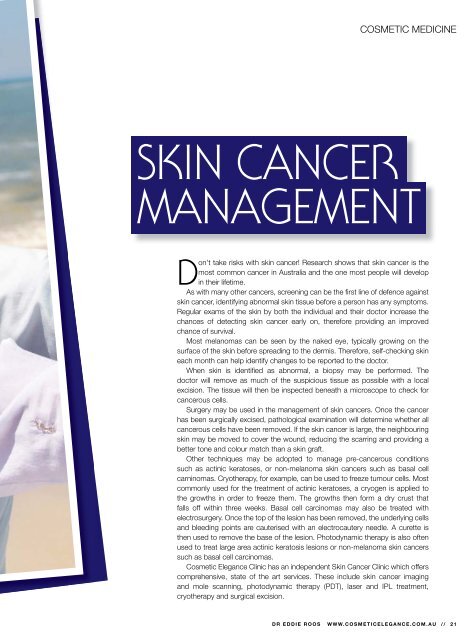Create successful ePaper yourself
Turn your PDF publications into a flip-book with our unique Google optimized e-Paper software.
COSMETIC MEDICINE<br />
SKIN CANCER<br />
MANAGEMENT<br />
Don’t take risks with skin cancer! Research shows that skin cancer is the<br />
most common cancer in Australia and the one most people will develop<br />
in their lifetime.<br />
As with many other cancers, screening can be the fi rst line of defence against<br />
skin cancer, identifying abnormal skin tissue before a person has any symptoms.<br />
Regular exams of the skin <strong>by</strong> both the individual and their doctor increase the<br />
chances of detecting skin cancer early on, therefore providing an improved<br />
chance of survival.<br />
Most melanomas can be seen <strong>by</strong> the naked eye, typically growing on the<br />
surface of the skin before spreading to the dermis. Therefore, self-checking skin<br />
each month can help identify changes to be reported to the doctor.<br />
When skin is identifi ed as abnormal, a biopsy may be performed. The<br />
doctor will remove as much of the suspicious tissue as possible with a local<br />
excision. The tissue will then be inspected beneath a microscope to check for<br />
cancerous cells.<br />
Surgery may be used in the management of skin cancers. Once the cancer<br />
has been surgically excised, pathological examination will determine whether all<br />
cancerous cells have been removed. If the skin cancer is large, the neighbouring<br />
skin may be moved to cover the wound, reducing the scarring and providing a<br />
better tone and colour match than a skin graft.<br />
Other techniques may be adopted to manage pre-cancerous conditions<br />
such as actinic keratoses, or non-melanoma skin cancers such as basal cell<br />
carninomas. Cryotherapy, for example, can be used to freeze tumour cells. Most<br />
commonly used for the treatment of actinic keratoses, a cryogen is applied to<br />
the growths in order to freeze them. The growths then form a dry crust that<br />
falls off within three weeks. Basal cell carcinomas may also be treated with<br />
electrosurgery. Once the top of the lesion has been removed, the underlying cells<br />
and bleeding points are cauterised with an electrocautery needle. A curette is<br />
then used to remove the base of the lesion. Photodynamic therapy is also often<br />
used to treat large area actinic keratosis lesions or non-melanoma skin cancers<br />
such as basal cell carcinomas.<br />
<strong>Cosmetic</strong> Elegance Clinic has an independent Skin Cancer Clinic which offers<br />
comprehensive, state of the art services. These include skin cancer imaging<br />
and mole scanning, photodynamic therapy (PDT), laser and IPL treatment,<br />
cryotherapy and surgical excision.<br />
DR EDDIE ROOS WWW.COSMETICELEGANCE.COM.AU // 21


















